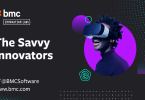Generative AI is one of the most exciting emerging technologies today, potentially revolutionizing many industries. However, as with any new technology, there is always the risk of a “Trough of Disillusionment,” when interest in a technology wanes as its implementations fail to deliver on its promises and unrealistic expectations lead to disappointment.
BMC HelixGPT is a generative AI platform designed to help businesses avoid that risk and achieve real success with the technology. BMC HelixGPT is a domain-specific generative AI model designed to help enterprises manage their IT infrastructure.
Here are just a few examples of how BMC HelixGPT uses its knowledge of IT systems and processes to help businesses achieve impactful results by integrating generative AI:
- Automate IT tasks, such as provisioning new servers and configuring applications, to free up IT staff to focus on more strategic initiatives.
- Identify and resolve IT problems more quickly and efficiently by analyzing data from multiple sources to identify the root cause of problems and recommend solutions.
- Provide insights into IT operations that can help businesses to improve their efficiency and performance by identifying bottlenecks and suggesting ways to improve data flow and applications.
Generative AI is embedded throughout the BMC Helix for ServiceOps platform, and is already yielding benefits for BMC customers.
As generative AI continues to mature with increase adoption, its long-term success will depend on avoiding the “Trough of Disillusionment,” which could happen within the next few years as more businesses begin experimenting with the technology and its limitations become more evident.
However, businesses that use a platform like BMC Helix for ServiceOps and generative AI capabilities such as BMC HelixGPT can avoid that by leveraging the technology to solve real-world problems and using it responsibly and ethically. Here are some ways BMC HelixGPT mitigates common risks when integrating generative AI.
- Tuning for IT, HR, enterprise service management (ESM), and operations use cases and all contextual data (whether offline, historic or in real time) ensures that BMC HelixGPT focuses on answers related to an enterprise based on its own enterprise data lakes, not outside information.
- The embedded security layer is domain- and tenant-specific.
- Enterprises have the power to not only restrict the scope of queries, such as to business-related questions only, but also have the flexibility to bring their own models from other GPT or generative AI vendors such as Azure, OpenAI, and Google, keeping their investments in generative AI safe and synchronized with advancements in GPT and large language model (LLM) technology.
Yes, these are early days for understanding the full power of generative AI. However, with the right business partner and trusted, proven solutions like those offered by BMC Helix, enterprises can capitalize on the promise of generative AI responsibly.
To learn more about BMC Helix for Service Ops, visit bmc.com/serviceops. To learn more about BMC Helix GPT, visit bmc.com/helixgpt.







